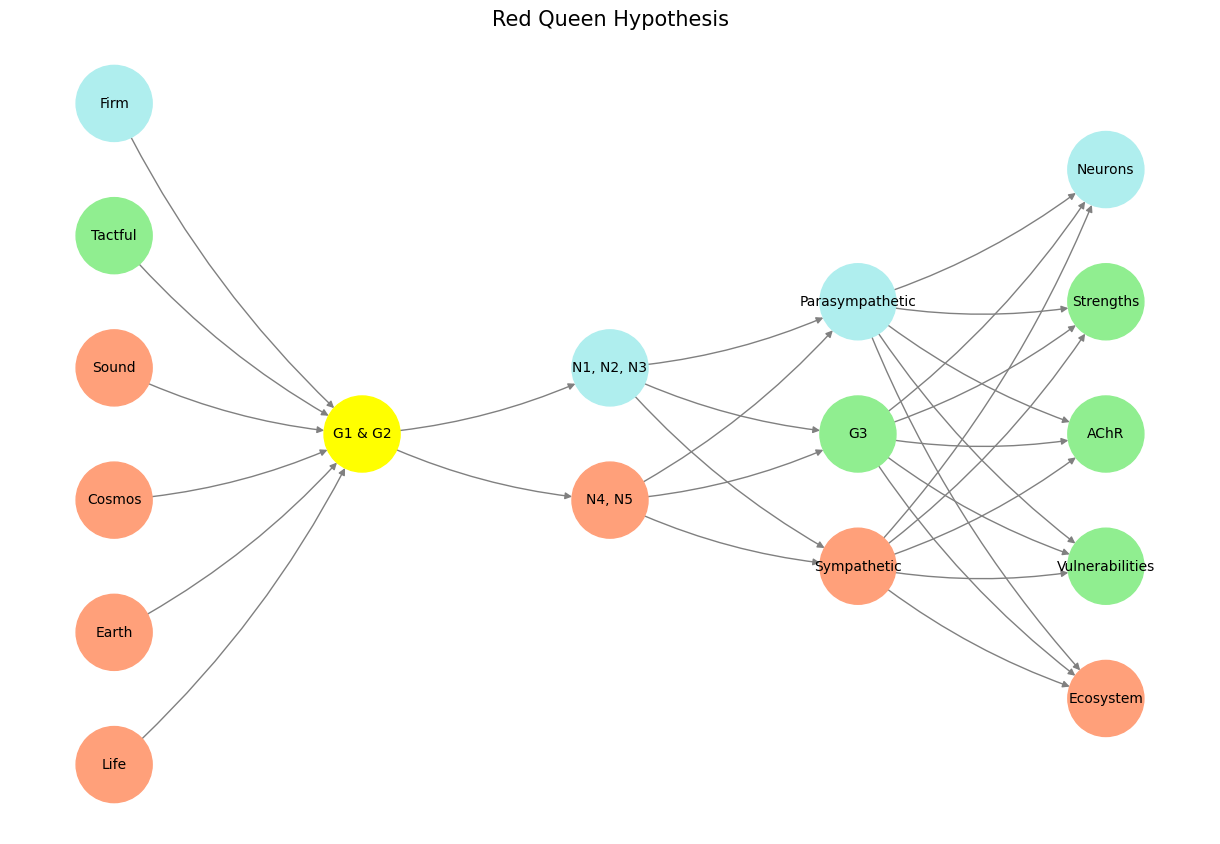Tactical#
Let’s dismantle the rigid scaffolding of traditional business school models like SWOT and Porter’s Five Forces. These frameworks, though once revolutionary, are now antiquated snapshots of static ecosystems, incapable of capturing the fluid dynamism of the real world. In their place, we propose a neural network-inspired model that reflects the evolutionary architecture of the human brain—a system shaped by relentless Red Queen pressures, where survival is predicated on constant adaptation.
The Red Queen Neural Framework#
This model redefines strategic thinking by embracing the interplay of co-evolutionary dynamics, leveraging a neuroanatomical and ecological lens. It thrives on complexity, reflecting how ecosystems—and by extension, businesses—must evolve in lockstep with shifting environments. Key components of this neural architecture include:
Pre-Input Layer: The primordial forces of “Life,” “Earth,” and “Cosmos,” which shape the contextual backdrop of existence. These inputs mirror foundational factors such as environmental constraints, global trends, and existential threats.
Yellowstone Layer (G1 & G2): Inspired by the Yellowstone wolf reintroduction that recalibrated the entire ecosystem, this layer captures disruptive forces capable of resetting equilibria, such as technological breakthroughs or regulatory upheavals.
Input Layer (N1–N5):
Represents multi-faceted sensory and contextual data streams, akin to how the basal ganglia and thalamus integrate and filter information.
Nodes include cognitive (N1, N2), affective (N3), and operational (N4, N5) drivers of strategy.
Hidden Layer:
Sympathetic Node: Encodes adversarial pressures and responses, akin to fight-or-flight mechanisms in competitive environments.
Parasympathetic Node: Balances iterative and cooperative strategies, fostering long-term resilience.
G3 Node (Autonomic): Bridges extremes, ensuring adaptive stability through feedback loops.
Output Layer:
Projects strategic outcomes such as “Ecosystem” health, “Vulnerabilities,” “AChR” (adaptive choke points), and “Neurons” (innovation hubs), emphasizing interdependence over standalone metrics.
Why This Model Triumphs#
Dynamic Integration: Unlike SWOT’s static matrix or Porter’s linear forces, this model evolves dynamically, accommodating feedback and emergent patterns from interconnected layers.
Biological Precision: The brain’s architecture serves as an elegant analogy for business ecosystems, with layers representing the interplay of evolutionary pressures (Red Queen hypothesis) and co-adaptive resilience.
Neuroecological Insight: The focus on acetylcholine (ACh) pathways highlights vulnerabilities and strengths through a lens of ecological and pharmacological co-evolution—paralleling how businesses must address systemic vulnerabilities.
Applications Across Domains#
Business Strategy: Replace static SWOT matrices with dynamic, real-time mapping of vulnerabilities, strengths, and emergent threats (e.g., teaching mediums unsuitable for Gen Z students).
See also
elevator-pitch
Healthcare Innovation: Use the framework to predict adaptive responses to shifts in ecosystems (e.g., pandemics, regulatory changes).
Ecological Systems: Model co-evolutionary pressures to guide conservation and sustainability efforts.
Show code cell source
import numpy as np
import matplotlib.pyplot as plt
import networkx as nx
# Define the neural network structure
def define_layers():
return {
'Pre-Input': ['Life', 'Earth', 'Cosmos', 'Sound', 'Tactful', 'Firm'],
'Yellowstone': ['G1 & G2'],
'Input': ['N4, N5', 'N1, N2, N3'],
'Hidden': ['Sympathetic', 'G3', 'Parasympathetic'],
'Output': ['Ecosystem', 'Vulnerabilities', 'AChR', 'Strengths', 'Neurons']
}
# Assign colors to nodes
def assign_colors(node, layer):
if node == 'G1 & G2':
return 'yellow'
if layer == 'Pre-Input' and node in ['Tactful']:
return 'lightgreen'
if layer == 'Pre-Input' and node in ['Firm']:
return 'paleturquoise'
elif layer == 'Input' and node == 'N1, N2, N3':
return 'paleturquoise'
elif layer == 'Hidden':
if node == 'Parasympathetic':
return 'paleturquoise'
elif node == 'G3':
return 'lightgreen'
elif node == 'Sympathetic':
return 'lightsalmon'
elif layer == 'Output':
if node == 'Neurons':
return 'paleturquoise'
elif node in ['Strengths', 'AChR', 'Vulnerabilities']:
return 'lightgreen'
elif node == 'Ecosystem':
return 'lightsalmon'
return 'lightsalmon' # Default color
# Calculate positions for nodes
def calculate_positions(layer, center_x, offset):
layer_size = len(layer)
start_y = -(layer_size - 1) / 2 # Center the layer vertically
return [(center_x + offset, start_y + i) for i in range(layer_size)]
# Create and visualize the neural network graph
def visualize_nn():
layers = define_layers()
G = nx.DiGraph()
pos = {}
node_colors = []
center_x = 0 # Align nodes horizontally
# Add nodes and assign positions
for i, (layer_name, nodes) in enumerate(layers.items()):
y_positions = calculate_positions(nodes, center_x, offset=-len(layers) + i + 1)
for node, position in zip(nodes, y_positions):
G.add_node(node, layer=layer_name)
pos[node] = position
node_colors.append(assign_colors(node, layer_name))
# Add edges (without weights)
for layer_pair in [
('Pre-Input', 'Yellowstone'), ('Yellowstone', 'Input'), ('Input', 'Hidden'), ('Hidden', 'Output')
]:
source_layer, target_layer = layer_pair
for source in layers[source_layer]:
for target in layers[target_layer]:
G.add_edge(source, target)
# Draw the graph
plt.figure(figsize=(12, 8))
nx.draw(
G, pos, with_labels=True, node_color=node_colors, edge_color='gray',
node_size=3000, font_size=10, connectionstyle="arc3,rad=0.1"
)
plt.title("Red Queen Hypothesis", fontsize=15)
plt.show()
# Run the visualization
visualize_nn()


Fig. 1 This neural framework doesn’t just compete with business school orthodoxy—it devours it, much like evolutionary fitness reshapes species. By aligning strategy with the architecture of life itself, we transcend the tokenized simplicity of existing models and enter a realm of adaptive, iterative brilliance. Let’s move over, SWOT. The corresponding nodes have the following undertones: Firm - institutional Apollonian aspirations & ends (monumental history; Amadeus), Tactful - enterprises Athenian vanguard & justification (critical history; Ludwig), Sound - well-troden journey & means (antiquarian history; Bach), Cosmos - indifference of the universe to your institutions fate (benchmark risk; Epicurus), Earth - well-tempered atmospheric conditions (freedom in fetters; Dionysus); Life - an elaborate dance in chains (princely freedom; Zarathustra)#

